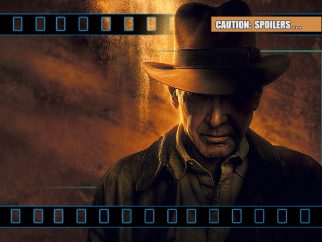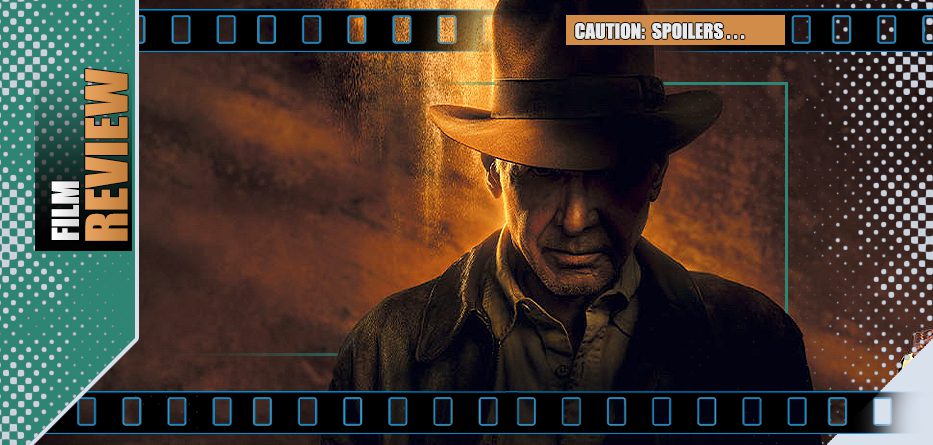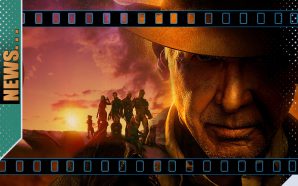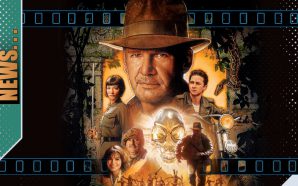Indiana Jones never liked Nazis – too often their pursuit of power got in the way of his pursuit of history. But by the time the 1970s come around, Henry ‘Indiana’ Jones may feel his best days are behind him. He’s lost his family and the students he tries to teach are more concerned with the future than the past.
But in the wake of World War II, some of those Nazis made deals that ensured their lack of accountability as mankind reached for the stars with their technology. Now, one of those supremacists is looking for the next frontier. Not space… but time. When Indiana’s god-daughter Helena comes crashing back into his life, on the trail of completing an object said to have been built by Archimedes, Jones finds himself caught between Helena’s dreams of money and fame and an old adversary’s desire to literally rewrite the past.
Now it seems, Indiana Jones has a final date with Destiny…
*spoilers*
The man with the hat is back… and this time he’s brought an army of post-production artists. The most ironic thing here is that of all the elements that go to make up Dial of Destiny, you’d almost expect it to be the de-ageing factor that would let the film down. As little as ten years ago it would have to have been Indiana Jones and the Uncanny Valley (referring to the unconvincing disconnect between CGI and real-life, especially in recreating a person’s eyes). But it’s actually the twenty-minute opening, complete with the tweaked Harrison Ford visage (if not quite a youthful voice) that convinces the most here and wholly captures a major part of the original magic before substituting size for actual depth. There’s still a 1% factor in the performance-capture that suggests there’s been no legitimate time-travel in the making of the film, but it’s damn close and about as perfect as it needs to be. And from the start Harrison Ford is undeniably the soul of the film, weathered though he might be and more akin to shouting ‘Get off my lawn/fire-escape..!‘ than running from giant boulders. When Indy is at his crumudgeon-esque best is when the film really cracks the whip.
But Dial of Destiny doesn’t quite have the courage of its convictions. Raiders of the Lost Ark was not just a rollickin’ adventure it was also had solid pacing, chaptered out in a way that felt like a swashbuckling story. It had its famous and infamous franchise-creating set-pieces that became blockbuster benchmarks and made whip-work fashionable again (kudos, Anthony DeLongis) but it knew when less was more and made you wait for a pay-off. Here, the main spin of Dial… is that it’s too often and too quickly cranked up to a default ‘eleven’, almost constantly going with the more is more maxim and that means horse/car chases through New York and its subway system go from thrilling to just plain silly and barreling cart chases through Moroccan side-streets last far too long. Practical effects make way for pixels and dominate thereafter.
For Dial of Destiny, it’s Indiana Jones that goes missing… not because of Harrison Ford’s age (another potential obstacle that the veteran actor navigates with reasonable ease) but because the film doesn’t make him essential, merely its mascot – he’s dragged along by the other supposed star: the modern cinema’s reliance on scale… When Indy is at his crumudgeon-esque best is when the film really cracks the whip…
There’s a famous argument that despite the original’s stature, Indiana himself doesn’t change much of the main outcome of Raiders of the Lost Ark‘s events – that they would have largely played out the same way without him. For Dial of Destiny, it’s Indiana Jones that goes missing… not because of Harrison Ford’s age (another potential obstacle that the veteran actor navigates with reasonable ease) but because the film doesn’t make him essential, merely its mascot – he’s dragged along by the other supposed star: the modern cinema’s reliance on scale. For a while it works, a few key – quieter – scenes such as what happened to Indiana’s son ‘Mutt’, resonate with the emotions missing elsewhere, but by the time we’re two thirds of the way into the feature, it becomes clear that it’s going to suffer from the modern malady of being a high-speed, high-concept delivery system that ducks and covers without a pre-ordained climax, reliant on nostalgia as its story-engine but unwilling or unable to bring it all together to stick the landing with any sense of satisfying logic. This is a film that careers along, and fails to differentiate what Mr. Hoegh, my school’s science teacher noted about speed and velocity… only one of those has direction. Dial… doesn’t. One can almost hear the scribbling of pens and rapid clicks of rewriting keyboards desperately trying to make a lick of sense of the film’s scattershot nature and unfortunately it all comes crashing down in an ill-judged time-travel ending that may traverse entire millennia yet still goes nowhere. Close to the end, in the midst of what is supposed to be the defining action set-piece (one that left me thinking ‘I’m supposed to be excited by this, but I’m just not…‘ Indiana makes a fateful choice that would – history be damned – actually make an emotional sense and provide bookend closure to the character, but even that is snatched away and in its stead is a rather soppy, downbeat kitchen-sink epilogue that’s only emotional because of a key cameo.
Mads Mikkelsen as Voller is a strong actor when given good material and, on paper, it’s easy to make the case for him as a suitable uber-villain. In fact, the idea that he’s almost Dark Indy, a disdainful, arrogant Nazi scientist and historian who knows the importance of these relics far more than thegeneric army of stupid white supremacist goose-steppers is a potentially rich seam to excavate. He recognises and respects that power while trying to channel it for personal power. But like everything else about the film he devolves into not just a caricature but an ineffective one, floundering around and playing catch-up. He postures and postulates but grows less and less interesting by the scene until his inevitable demise (which doesn’t even really come at the hands of Indy).
Phoebe Waller-Bridge is a strong writer and star of her own material (such as the award-winning Fleabag) and the idea of Indy having a god-daughter (Helena) who is imbued with the same sense of adventure – but for less altruistic purposes – is a decent-enough idea on paper and given equally decent form by the actor. But Helena seems to be required to do too much or too little, a Mary-Sue creation written as if she’s been primed for her own spin-off but no-one’s quite sure how to package it yet. Equally, her young sidekick Teddy is played capably by relative newcomer Ethann Isidore but all too often feels like someone has written ‘Short Round-ish character’ and then had an AI scripter fill in the blanks, making him good at whatever the page/scene needs (pickpocket, driver, sudden first-time pilot). Boyd Holbrook, a strong actor in his own right is little more than a sneering henchman here, to the extent I challenge to remember if he even has a name. There’s a few other familiar-faces along the way: Toby Jones is a key part of the introduction sequences and is reliable as ever. John Rhys-Davies reprises Sallah and it’s always great to see the actor enjoying himself but Antonio Banderas turns up as an old sea-faring ally in a thankless Popeye-ish role that makes you wonder why he bothered. Shaunette Renée Wilson’s CIA agent and the whole early sub-plot about the US using Nazis foe technology quickly seems surplus to requirements. It all too often feels like they’re all potential characters and story-points thrown at the white-board and somehow they all ending up sticking.
Raiders‘ trek amongst the Egyptian tombs and relics may have been made for Saturday-morning serial enthusiasts, but they mostly felt vaguely plausible within that world. However, the stakes for Dial of Destiny never seem high, all artificial connective tissue and vague prophetic musings that feel more like someone raided a script for National Treasure: The Series. The Ark of the Covenant was a wholly and holy historical artifact beyond the screen that was worth chasing (even providing the audience with some genuine historic myths), but here even Indiana Jones himself rolls his eyes at Toby Jones’ obsession with a relic that might predict time portals and chronological fissures because the script has decided it must. The trail of clues Indy discovers also makes no real sense, there to be enigmatic (though easily deciphered by Helena) and an inconsistent travelogue (they went from where to where, how?), Yet as we head to Archimedes final resting place it turns out to be a few feet away from a tourist landmark where people come to shout and hear the echoes, a little like finding Lord Lucan at Aldi by taking a wrong turn on Aisle Three. Indy and his pursuers merely have to navigate a few extra feet of tunnels, a de rigeur rickety rope-bridge over an underground river to find a coffin that even Don Wildman and his Discovery Channel show would have found it in half the time. In short, for all the shooting, ducking, whipping, jumping, it’s the script and a shrug that provides the answers rather than our heroes.
Despite all of the above, Dial of Destiny isn’t a bad film per se – you can enjoy it in the moment. James Mangold who has created such memorable outings as Stallone’s finest hour CopLand, superior slasher Identity and two satisfying Wolverine film, including the amazing Logan, was a competent choice for the director’s chair and there’s a lot of talent involved… and as summer blockbusters go, I’ve seen far worse done with far more. It’s just that the result is merely a near-hit, a just-missed opportunity: big but basic, sprawling but cluttered… obviously ambitious but also inherently lazy, one that hoped its core mixture of nostalgia and high-octane set-pieces will capture the lightning again by osmosis, but which doesn’t quite put in the firm foundational groundwork to make it happen.
It’s not the years, honey, it’s the mileage and ultimately this is a picturesque, odometered story-arc, but without a covenant…

- Story7
- Acting8
- Direction8
- Production Design / VFX8











